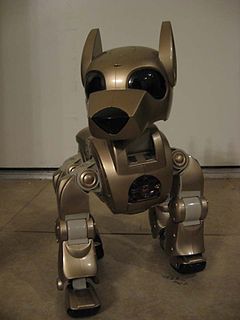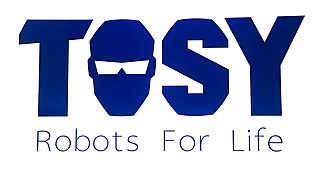Related Research Articles

Mark W. Tilden is a robotics physicist who produces complex robotic movements from simple analog logic circuits, often with discrete electronic components, and usually without a microprocessor. He is controversial because of his libertarian Tilden's Laws of Robotics, and is known for his invention of BEAM robotics and the WowWee Robosapien humanoid robot.
WowWee Group Limited, is a privately owned, Hong Kong-based Canadian consumer technology company.
An entertainment robot is, as the name indicates, a robot that is not made for utilitarian use, as in production or domestic services, but for the sole subjective pleasure of the human. It serves, usually the owner or his housemates, guests or clients. Robotics technologies are applied in many areas of culture and entertainment.
Roboraptor is a robotic toy invented by Mark Tilden in 1999, and then distributed by Wow Wee Toys International. It is the successor to the RoboSapien robot and uses motion technology based on realistic biomechanics that give it fluid and natural movements. It has a multi-function remote control that uses infrared technology to talk to it. Unlike the original RoboSapien, the Roboraptor is capable of autonomous movement, using 3 realistic gaits.

i-Cybie (爱赛比) is a robotic pet that resembles a dog. It was manufactured by Silverlit Toys Manufactory Ltd Hong Kong from 2000 to 2006. i-Cybie was developed for commercial distribution by Tiger Electronics. Outrageous International Hong Kong distributed the electronic pet from 2005 to 2006. The i-Cybie robotic dog responds to sound, touch, movement, and voice commands. The toy robot can autonomously recharge its batteries using a special docking station. I-Cybie was the first mass-produced toy that used advanced voice recognition technology.
The Robosapien V2 is the second generation of Mark Tilden's Robosapien robot. It is nearly twice the size of the original robot, standing around 1.85 feet (56 cm) tall. Instead of the original caveman grunts, the V2 can speak a large list of pre-recorded phrases. It has infrared and basic color recognition sensors, grip sensors in its hands, touch or contact activated hand and foot sensors, and sonic sensors. For movement, the V2 has an articulated waist, shoulders, and hands giving him a variety of body animations.
The Roboreptile is a toy robot manufactured by sphero Ltd. The Roboreptile has infrared and sound sensors, and is able to autonomously explore its environment while avoiding obstacles. It can also operate in different modes where it simulates behaviors of real animals. It is able to rear up on its hind legs and attack. Roboreptile was released in China on the 28 April 2006 and to the rest of the world later that year. It is superficially similar to a theropod or a prosauropod dinosaur but being quadrupedal it's better equated to a silesaurid or a monitor lizard.

The Alive Chimpanzee is produced by WowWee Alive, a division of WowWee Ltd. The animatronic Chimpanzee is the first in WowWee Alive's product line. Unlike WowWee's other robots, the Chimpanzee only consists of the head of a chimpanzee. It houses eight motors to mimic the facial expressions of a real chimp. It also contains 9 sensors, including IR sensors in the eyes, touch sensors on the chin, top and rear of the head and sound and vibration sensors in the ear. There is also an Alive Elvis manufactured.

Microsoft Robotics Developer Studio is a discontinued Windows-based environment for robot control and simulation that was aimed at academic, hobbyist, and commercial developers and handled a wide variety of robot hardware. It required the Microsoft Windows 7 operating system or later.
The Flytech Dragonfly is a remote-controlled flying toy manufactured by WowWee. The Dragonfly has been incorrectly billed as the world's first commercially available RC ornithopter. It was actually preceded by several other products, including Hobbytechnik's Skybird, Park Hawk, and Slow Hawk radio controlled ornithopters, and the Cybird radio-controlled ornithopter from Neuros.
The RS Media is another product in WowWee's line of biomorphic robots, based on a walking system designed by Mark Tilden. The RS Media uses basically the same body as the Robosapien V2, but a different brain based on a Linux kernel. As the name implies, the RS Media's focus is on multimedia capabilities, including the ability to record and playback audio, pictures and video. he retains and builds upon the Robosapien V2's sensor array and programmability.
Referred to as "The first true robotic arthropod," Roboquad is one of the 5 robots that WowWee announced at CES in January 2007. It is a 4-legged robot that somewhat resembles a spider and a dog. Also designed by Mark Tilden, the Roboquad, like other WowWee robots, has multiple personalities, awareness of its surroundings, some autonomous behaviour and can be controlled via a remote.
Robopanda is a robotic interactive companion produced by WowWee. The Robopanda uses interchangeable cartridges that contain personalities, stories and songs, and is controlled directly by touch and sound sensors. Robopanda is labeled for use by children ages 9 and up.
Roboboa is a robotic snake produced by WowWee. Roboboa has 4 angled body sections, allowing Roboboa to coil by rotating adjacent sections. A motorized tail roller and casters on the midsection allow Roboboa to move in a straight line.
Tomotaka Takahashi, roboticist and founder of Kyoto University's ROBO-GARAGE since 2018, creates humanoid robots known for their smooth, fluid motions and sleek appearance. Creating a number of humanoid robots entirely by himself, from concept through to production, Takahashi's designs have been featured in art exhibitions celebrating the creation of Astroboy, Time Magazine's Coolest Inventions of 2004, and promotions for Bandai, Panasonic, and Pepsi. He has also worked with toy companies to produce relatively inexpensive robots for the hobby market, including those for Kyosho.
Domestic robots can vary widely in their capabilities and tasks. Sensors include: cliff or stair sensors, motion sensors, ultrasonic object sensors, dirt sensors, IR sensors, and more. Intelligence varies also. Some have none while others can map out their environment and maneuver using complex algorithms.

TOSY Robotics specializes in designing and manufacturing robots and smart toys. The most famous products from TOSY Robotics are TOPIO Robot, DiscoRobo, TOOP and AFO.
Ropid is a tiny robot designed and developed by Tomotaka Takahashi of Robo Garage at Kyoto University. The name of the robot is a combination of Robot and Rapid.
RoboSapien is a toy-like biomorphic robot designed by Mark Tilden and produced by WowWee toys. The Robosapien X was made to entertain and will react to sounds and touch. The Robosapien is preprogrammed with moves, and also can be controlled by an infrared remote control included with the toy, or by either a personal computer equipped with an infrared PDA.
Atlas is a bipedal humanoid robot primarily developed by the American robotics company Boston Dynamics with funding and oversight from the U.S. Defense Advanced Research Projects Agency (DARPA). The robot was initially designed for a variety of search and rescue tasks, and was unveiled to the public on July 11, 2013.
References
- 1 2 3 Peter Redmer (2008-01-16). "Hands On with the WowWee FemiSapien at CES 2008". RoboCommunity. Retrieved 2008-06-24.
- ↑ RoboCommunity Team (2008-01-14). "WowWee Robots 2008 - Release Dates and Pricing Guide". RoboCommunity. Archived from the original on 2008-09-16. Retrieved 2008-06-24.
- ↑ "Femisapien". RoboCommunity. Archived from the original on 2008-06-03. Retrieved 2008-06-24.
- ↑ RoboCommunity Team (2008-06-22). "'Lovable' robot". CNN.com. Retrieved 2008-06-24.
- ↑ "RobotShop | Robot Store | Robots | Robot Parts | Robot Kits | Robot Toys".